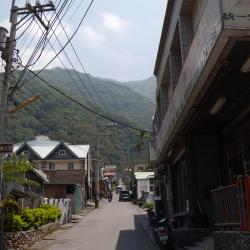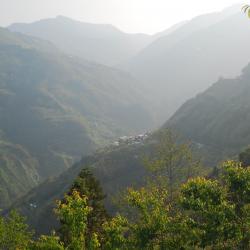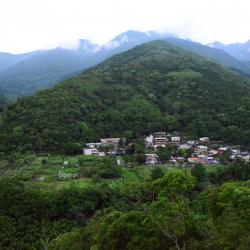The Aisaka (Fengban) Anti-Japanese Monument is located between Xinwu and Chulai on the Southern Cross-island Highway, near the former site of Fengban Police Post in Haiduan Township, Taitung County. The monument was erected in memory of the Aisaka incident that occurred in the middle of the Japanese occupation period. The incident was caused by the Bunun people of the Bulakusan and Tokoban group attacking the Aisaka Police Post in 1933 and killing the Chief Inspector and his family members. After that, the Governor-General in Taiwan fired at Burakusan Hamlet, formed a search team to attack from Hualien, Taitung and Kaohsiung, and finally arrested the suspects. However, in order to take into account the overall situation, the Governor-General adopted a peaceful punishment and held an apologetic ceremony to accept the people’s submission. In the post-war period, the Haiduan Township Office built a simple monument to commemorate this anti-Japanese incident.
Settlement
Mashuhor Police Post is located on the east side of Meishan Hamlet in Taoyuan District, Kaohsiung City. To get there, enter the industrial road next to the Meishan Youth Activity Center, then walk further for about 1 km. The former site of the Meishan Hamlet is located above the current hamlet. The traditional Bunun name is Masuhuaz, which means yellow rotang palm, because the area is rich in yellow rotang palm. In the post-war period in 1961, the National Government forced the tribes to collectively move here. The place was then renamed to Meishan because of the abundance of plum trees.
Today, the original building of Mashuhor Police Post no longer exists. Only the foundation of the house, the stone wall, the reservoir, the entrance and exit steps remain but are covered by overgrown grass.
Meimu Police Post, in Ren'ai Township of Nantou County, is located below the Lixing Industrial Road and next to the Meimu Camphor Bureau. It has now been converted into a tea factory.
The Lixing Industrial Road was completed in 1968. The road begins from Wushe in the south and ends in Lishan in the north, connecting to the Central Cross-island Highway. The section from Meimu to Cuiluan was originally part of the Pyanan Historic Trail during the Japanese Occupation period.
Today, the hillsides along the Lixing Industrial Road are rich in non-tropical fruits, but the geology of the area where the road passes is fragile. There are often landslides, hence the road conditions are not good.
The old Ruiyan police station, in Ren’ai Township of Nantou County, is located in the northeastern foothills where Beigang River and Kagao River meet.
The Ruiyan Hamlet was formed by the merger of the Mesiduobang community and the Tieli Lao community. Since Japanese rule, it has experienced multiple group migration policies. In the post-war period, the National Government also changed the name of the hamlet and merged. It was until the Jiji earthquake in 1999 that the Ruiyan Hamlet was relocated again in 2011 due to severe stratum damage. The new location of the hamlet is on the right bank of Beigang River, northwest of the original village. However, there are still 32 households that have not moved due to insufficient land.
Baigou Police Post, located in Ren'ai Township of Nantou County, used to stand at the fork of the industrial road leading to Ruiyan hamlet. It is 1,349 meters above sea level.
During the Japanese occupation, the Government-General in Taiwan built the Pyanan Historic Trail in 1918 for the purpose of supply transportation and management of indigenous people. The trail is 120 km in length.
In the post-war period, the trail section from Siyuan Pass to Datong in Yilan was replaced by the Central Cross-island Highway, and the section from Meimu to Cuiluan was later opened as part of the Lixing industrial road.

Tamarowan Hamlet is located on the river terrace on the north bank of the upper reaches of Zhuoshui River in Dili Village, Xinyi Township, Nantou County. Traditionally the Bunun named the place Tumazuan, also known as Damaluan.
In the early days of the Japanese occupation, this area was a forest. After the implementation of the relocation policy by the Government-General in Taiwan, the Bunun people from Shuanlong Hamlet of the Luanshe group and the Danda Hamlet, Tai-ersan Hamlet, Kanetwan Hamlet of the Danshe group successively moved here and formed a new Tamarowan Hamlet.
Today, you can reach Dili Village from the Provincial Highway 16 in Shuili Township, Nantou County, and the outpost is the gateway into the old Bunun hamlet sites and the Danda Forest Road.

The Kara Hamlet is located 3 km northeast of Shangbaling in Fuxing District, Taoyuan City, on the hillside on the south bank of Daguan River. It sits 900 meters above sea level, and the traditional Atayal name is Qara, which means separate or branch.
In the past, two brothers had to separate due to insufficient hunting grounds. The eldest brother and his family stayed in today’s Baling Hamlet, while the younger brother took their family and arrived at the old tribe, which is on the hill opposite to the current Kara Hamlet.
Many years ago, due to typhoons the people moved to Kara hamlet for the safety of their homes and traffic reasons. It is a hamlet of around 20 households, mainly living in the vicinity of the boat-shaped church.

The Fushan Hamlet is located in the upper reaches of Nanshi River in Wulai District, New Taipei City. It was the earliest hamlet established by the Atayal people in Wulai District during the Qing period. They were the Talanan and Limao-an tribes.
Later, due to the increased population, the tribes began migrating to the lower reaches of Nanshi River. Through social changes, the people living in Fushan hamlet further established the Tunlu, Limao’an, Karamuki and Daluolan hamlets.
During the Japanese occupation, the Governor-General in Taiwan set up the Limao’an Police Post in Limao’an hamlet. After that, the Mitsui Gomei Company took the land and forced the people to move. In the post-war period, the National Government delineated the administrative area and merged the hamlets into Fushan village.